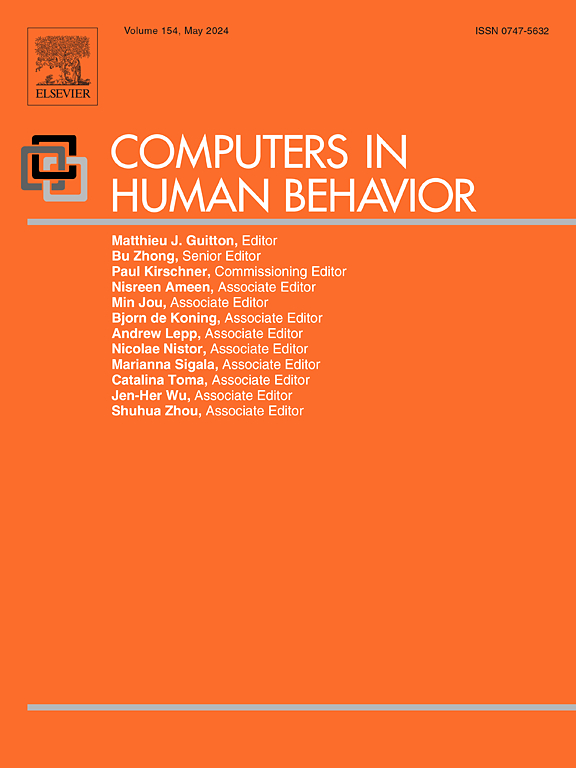屏幕时间问题:青少年的社交媒体发帖、滚动、外化行为和焦虑
IF 9
1区 心理学
Q1 PSYCHOLOGY, EXPERIMENTAL
引用次数: 0
摘要
青少年使用屏幕时间在大流行期间显著增加。过度使用社交媒体和长时间使用屏幕是内化和外化行为的风险因素。然而,对于使青少年易患不良后果的预先存在的因素,以及定量(如花费的时间)和定性(如屏幕使用行为)方面与心理健康(包括焦虑和情绪/行为困难)之间的关系,了解仍然有限。了解这些联系对于在卫生保健和教育领域提出循证建议至关重要。从2022年12月至2023年8月,以社区为基础的580名年龄在12-17岁的青少年参加了一项在线调查。通过自我报告问卷收集人口统计数据、先前存在的脆弱性、屏幕使用情况、情绪和行为困难以及焦虑。分析了工作日和周末在屏幕上花费的时间,以及屏幕使用行为,如使用频率、总时间、被动滚动和在社交媒体上发布内容。值得注意的是,大约45%没有先前存在的脆弱性的青少年在临床范围内报告了焦虑。优势比分析显示,工作日看屏幕时间超过2小时,临床焦虑升高的几率增加了一倍,经历情绪和行为困难的几率增加了四倍。虽然屏幕使用行为的不同方面显示出与心理健康结果的线性关联,但与主动屏幕使用或更一般的指标(频繁和长时间的屏幕时间)相比,被动滚动具有最强的负面影响,即使在控制了年龄、性别和先前存在的脆弱性之后。根据个人心理健康状况,特别是焦虑程度,管理屏幕时间和活动,可能有助于支持青少年的健康。本文章由计算机程序翻译,如有差异,请以英文原文为准。
Screen time woes: Social media posting, scrolling, externalizing behaviors, and anxiety in adolescents
Adolescent screen time use increased significantly during the pandemic. Excessive social media and prolonged screen use are risk factors for internalizing and externalizing behaviors. However, limited understanding remains of pre-existing factors that predispose adolescents to adverse outcomes, and how quantitative (e.g., time spent) and qualitative (e.g., screen use behaviors) aspects relate to mental health, including anxiety and emotional/behavioral difficulties. Understanding these links is critical for evidence-based recommendations in healthcare and education. A community-based sample of 580 adolescents aged 12–17 years participated in an online survey from December 2022–August 2023. Demographic data, pre-existing vulnerabilities, screen use, emotional and behavioral difficulties and anxiety were collected using self-report questionnaires. The time spent on screens during weekdays and weekends, as well as screen-use behaviors such as frequency of use, total time, passive scrolling, and content posting on social media were analyzed. Notably, about 45 % of adolescents without pre-existing vulnerabilities reported anxiety in the clinical range. The odds ratio analysis showed that exceeding 2 h of screen time on weekdays doubled the odds of clinically-elevated anxiety and quadrupled the odds of experiencing emotional and behavioral difficulties. Although different aspects of screen use behaviors showed linear associations with mental health outcomes, passive scrolling had the strongest negative influence, even after controlling for age, gender, and pre-existing vulnerabilities, compared to active screen use or more general indicators (frequent and prolonged screen time). Managing screen time and activities based on individual mental health profiles, particularly regarding anxiety levels, may help support adolescent well-being.
求助全文
通过发布文献求助,成功后即可免费获取论文全文。
去求助
来源期刊

Computers in Human Behavior
Multiple-
CiteScore
19.10
自引率
4.00%
发文量
381
审稿时长
40 days
期刊介绍:
Computers in Human Behavior is a scholarly journal that explores the psychological aspects of computer use. It covers original theoretical works, research reports, literature reviews, and software and book reviews. The journal examines both the use of computers in psychology, psychiatry, and related fields, and the psychological impact of computer use on individuals, groups, and society. Articles discuss topics such as professional practice, training, research, human development, learning, cognition, personality, and social interactions. It focuses on human interactions with computers, considering the computer as a medium through which human behaviors are shaped and expressed. Professionals interested in the psychological aspects of computer use will find this journal valuable, even with limited knowledge of computers.
 求助内容:
求助内容: 应助结果提醒方式:
应助结果提醒方式:


